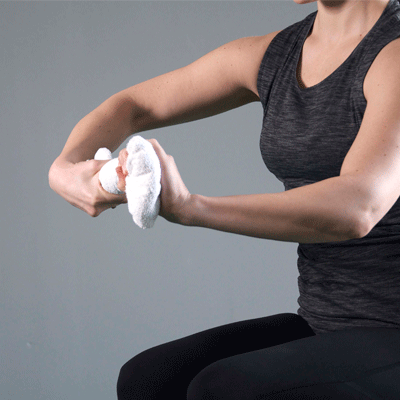Physical Therapy For Tennis Elbow
Tennis elbow, also known as lateral epicondylitis, is a condition that causes discomfort on the outer portion of the elbow. This typically develops from overuse of the wrist and finger extensor muscles that attach to tendons inside of the forearm. For more information on strengthening your elbow visit our Elbow pain page.
Physical therapy works to strengthen and stretch the forearm muscles, increasing their strength and range of motion. This improves blood flow to tendons that don’t get as much oxygen as muscles do, aiding in the speedy healing process.
Physical Therapy
Physical therapy is a non-invasive solution for relieving pain and improving mobility and movement. Your therapist can help you regain motion in your elbows and wrists so you can perform everyday tasks with less discomfort.
Your therapist can also instruct you on ways to avoid activities that put your elbow at risk for injury and suggest lifestyle modifications that reduce stress on muscles and joints. They may prescribe specific stretches and strengthening exercises so that you can return to your regular routine as quickly as possible.
Your therapist will conduct special tests to pinpoint the location of your tennis elbow problem and identify what might have caused it in the first place. They might suggest an X-ray or ultrasound for their diagnosis, as well as ice or heat treatments to help heal the injured area. With physical therapy, your therapist will teach you how to properly strengthen your elbow muscles to help avoid injury.
Anti-Inflammatory Medication
Anti-inflammatory medications, such as ibuprofen (Advil, Motrin) and naproxen sodium (Aleve), can help alleviate pain and inflammation. Furthermore, these drugs block the production of chemicals called prostaglandins which cause fever, swelling, and discomfort.
These drugs are typically prescribed to those with arthritis, rheumatoid arthritis, and other chronic pain conditions. Additionally, they provide short-term relief from acute back and neck discomfort.
Nonsteroidal anti-inflammatory drugs (NSAIDs) work by blocking certain proteins in the body that create prostaglandins, which cause pain and inflammation. Furthermore, NSAIDs lower blood pressure and the likelihood of kidney damage.
We reviewed the medical literature for randomized or quasi-randomised controlled trials that compared topical or oral NSAIDs with placebo or another intervention. Outcome measures included pain, function, quality of life, pain-free grip strength, overall treatment success rate, work loss and adverse effects.
Ultrasound
Ultrasound devices utilize sound waves that penetrate deep layers of tissue, making them an effective treatment for chronic tendon pain. As a safe and minimally invasive alternative to surgery which may take a long recovery time or leave patients with residual discomfort, ultrasound devices offer patients an alternative choice.
The procedure begins with the technologist applying gel to your skin, which both lubricates it and helps conduct ultrasound waves from and to a transducer (a wand-like instrument). This makes it easier for the ultrasound beam to travel through your body and produce images of any affected areas.
Ultrasound can also be used to detect injuries and diagnose disorders such as tennis elbow, which causes pain, stiffness and swelling in the tendons of the arm. Studies have demonstrated that ultrasound-guided steroid injections and platelet rich plasma (PRP) treatments are effective at relieving tennis elbow symptoms.
For patients who do not respond to conservative treatments, surgical procedures such as percutaneous tenotomy (TENEX) offer another treatment option. This involves inserting a needle into an injured tendon under ultrasound guidance and using high-energy sound waves to cause it to vibrate so quickly that damaged tissue liquefies and can be removed. Here are some other treatments that we offer that relate to ultrasounds.
X-Rays
X-rays can assist doctors in diagnosing tennis elbow by providing them with images of bone structures like tendons. Furthermore, an X-ray may detect arthritis, which may cause pain around the elbow and forearm.
In addition to X-rays, your doctor may order other tests to diagnose tennis elbow. A magnetic resonance imaging (MRI) scan can provide details on the soft tissues surrounding your arm.
Your doctor may order an electromyography test, which measures electrical activity in muscles. This can help them diagnose nerve compression as the likely cause of tennis elbow-associated pain.
Your physical therapist will work with you to identify and correct any imbalances in the wrist, forearm or postural muscles that could be contributing to tennis elbow. They may also suggest strengthening and stretching exercises that can increase elbow strength while decreasing the chance of recurrence.
If you’re experiencing tennis elbow or any other pain, don’t hesitate to contact us at Fluid Health & Fitness for a consultation and treatment plan tailored to your needs.



